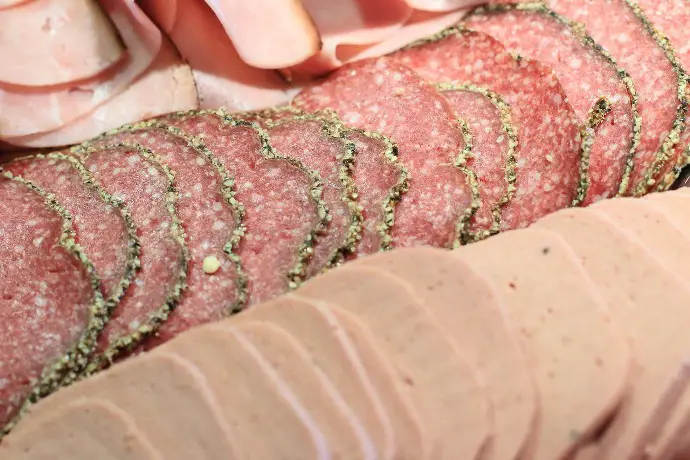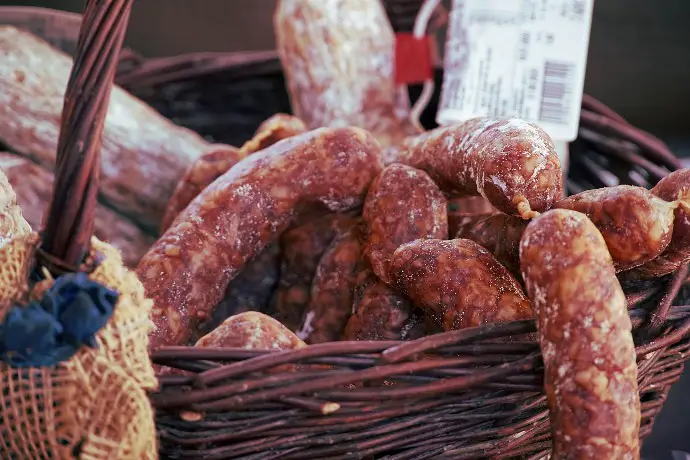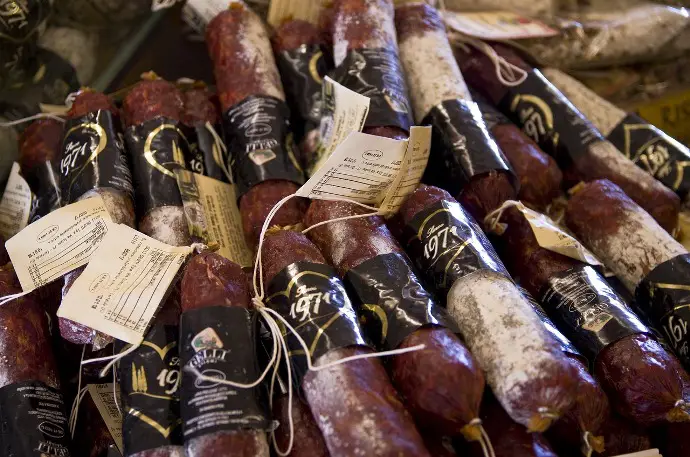Italian salami, a popular cured sausage in the culinary world, has a rich history that dates back millennia.
Its unique taste and appearance, including the distinctive white mold that covers its exterior, have made it a favorite among food enthusiasts.
The white mold is not just a cosmetic feature; it also plays a crucial role in protecting the meat from harmful bacteria.
However, the presence of black spots on salami can be a cause for concern, especially if you’re curing salami at home.
Identifying whether the black spots are black peppercorn or black mold is essential. While black peppercorn is a common ingredient in salami, black mold is not only unpleasant to look at but can also be harmful to consume.
Scroll down to read more!

Table of Contents
Understanding Black Spots on Salami
While some of these spots are harmless and a natural part of the salami-making process, others can be an indication of a serious issue.
Peppercorns: A Common Ingredient in Salami
When you cut into salami and see black spots, it’s likely that they are just peppercorns.
Peppercorns are an essential ingredient in many types of salami, providing them with a distinctive flavor. Before they are ground into a powder, peppercorns are small, hard black balls.
If you’re not familiar with the salami-making process, you may not realize that these spots are harmless.
Black Mold: A Potential Cause of Black Spots
While peppercorns are a common cause of black spots on salami, they are not always the culprit. If you’re confident that the black spots are not peppercorns, then they could be a sign of black mold.
This type of mold is caused by the bacteria Carnimonas nigrificans and can occur during the homemade production of cured sausage, but not exclusively.
If you purchased salami from a deli or supermarket and notice black spots, it’s less likely to be black mold.
Contamination and Fermentation
The presence of black mold is a clear indication of contamination during the curing and fermentation process.
It’s possible that the environment wasn’t sterile enough, or that other factors during the process weren’t optimal. In any case, discovering black mold on your salami is always a concerning indication.
Cured sausages, like salami, often contain sugars such as dextrin, maltose, or dextrose. The presence of these substances can exacerbate the growth of black spots.
Incorrect amounts of nitrates and sugars can also contribute to the development of black spots on your salami.
How to Tell the Difference
If the black spots are peppercorns, they will be small and hard. On the other hand, black mold will often have a fuzzy appearance and can be larger than peppercorns.
Additionally, black mold will have a distinctive odor, whereas peppercorns will not.
>>Also read: Potato starch sausage binder; and where is jimmy dean sausage made?
Is Black Spots on Salami Safe to Eat?

Black spots on salami can either be harmless or harmful to your health.
Black peppercorns are a common ingredient in salami, and they’re safe to eat. However, if you’re not a fan of spicy food, you might want to remove them before taking a bite. Black peppercorns are easily removable and won’t harm you if you accidentally ingest them.
Unlike black peppercorns, black mold on salami is not safe to eat. It can produce toxic chemicals called mycotoxins, which can cause allergic reactions and damage your respiratory system.
Always inspect the salami before consuming it. If you see any visible signs of mold, such as black or fuzzy spots, do not eat them.
>>Read more: Can You Eat Salami Raw? – The Unexpected Revelation!
Removing Black Spots from Salami: Is It Safe?
Removing black spots from salami can be risky, and it’s not a foolproof method to ensure safety. Starting over and discarding the salami with black spots is the safest option.
Even if you remove the black spots, there’s no guarantee that the mold hasn’t penetrated the entire sausage, making it unsafe to eat.
If you’re still determined to salvage your salami, you can try removing the black spots. Here are the steps you can take:
Inspect the Salami: Before attempting to remove the black spots, examine the entire sausage for any visible mold. If there’s mold inside the casing, it’s best to discard the salami.
Prepare a Cleaning Solution: Mix water, vinegar, and salt to create a cleaning solution. Dip a clean cloth in the solution and gently scrub the black spots.
Rinse and Dry: Rinse the salami under running water to remove any residue from the cleaning solution. Dry the salami with a clean cloth.
Re-Inspect the Salami: After cleaning, examine the salami again for any remaining black spots. If there are still visible black spots, it’s best to discard the salami.
Remember, safety should always be the priority.
How to Prevent Black Mold from Developing on Your Homemade Salami

If you’re a fan of homemade salami, you know how important it is to follow an authentic recipe and pay attention to every detail. Here are some tips on preventing the growth of black mold on your homemade salami.
Keep Your Tools Sterile
Before starting, ensure that all your equipment is clean and sterile. This includes your hands, workspace, and utensils.
Proper Ventilation
After drying, store your salami in a well-ventilated area. A lack of airflow in the storage room can cause moisture buildup, which is a breeding ground for mold.
Monitor Humidity Levels
Controlling the humidity level in the storage space is critical. Ideally, it should be around 45% to prevent moisture retention.
Use Beneficial Mold Culture
Covering your salami casings with a beneficial mold culture, such as white mold, can prevent the growth of black mold.
Black Mold vs. White Mold on Salami: What You Need to Know

First and foremost, if you see black spots of mold on your salami, it’s best to throw it out.
On the other hand, if you see powdery white mold on your salami, it’s a good sign. This type of mold forms during the curing and fermentation process and is actually beneficial.
It’s a natural part of the process and indicates that the salami has been appropriately treated. Salami with white mold is safe to eat and can even enhance the flavor.
In addition to white mold, some discolorations on salami are also safe. Light green, yellowing, or grey hues are all normal and don’t indicate spoilage.
Conclusion
Black mold is a type of fungus that can grow on various surfaces, including food items. However, identifying black mold in certain types of food can be tricky.
For instance, salami and other cured sausages can have black spots on them that might be confused with peppercorns or some other harmless speck. While black pepper is safe and spicy, black mold on salami is a big problem.
If you notice black spots on your salami or cured sausages, the safest course of action is to throw them away. Although you can try scrubbing off the black mold from the casings, it’s not always successful in removing all the mold spores.
>>Related Post: Chorizo vs Salami and How long is hickory farms summer sausage good for after expiration date?

Fernando is the creator and writer behind the food blog Eating with your Hands. Living and working in cities like Paris, Barcelona, and Berlin, and being married to a Canadian foodie, has given Fernando a passion and interest in food and inspired him to run EWYH.
